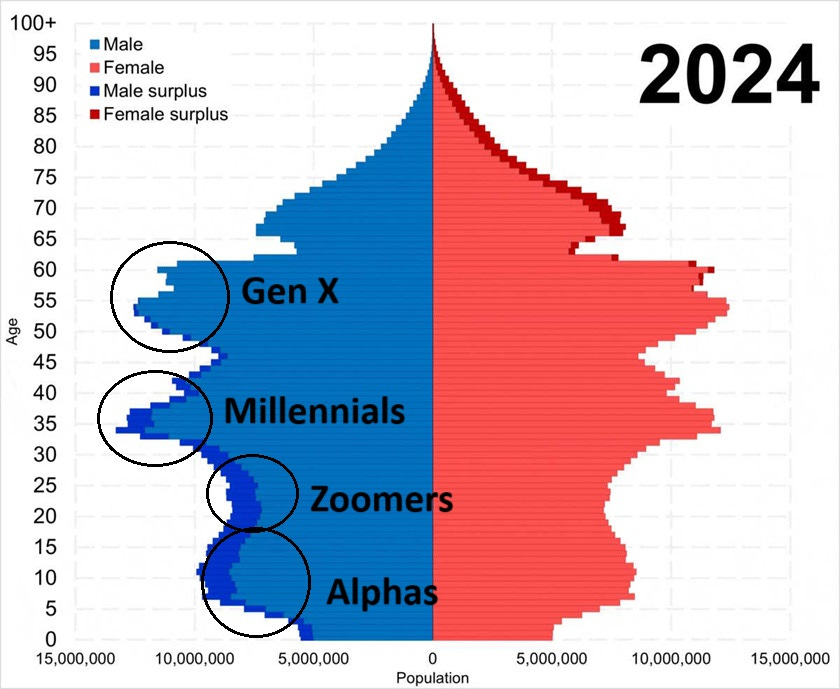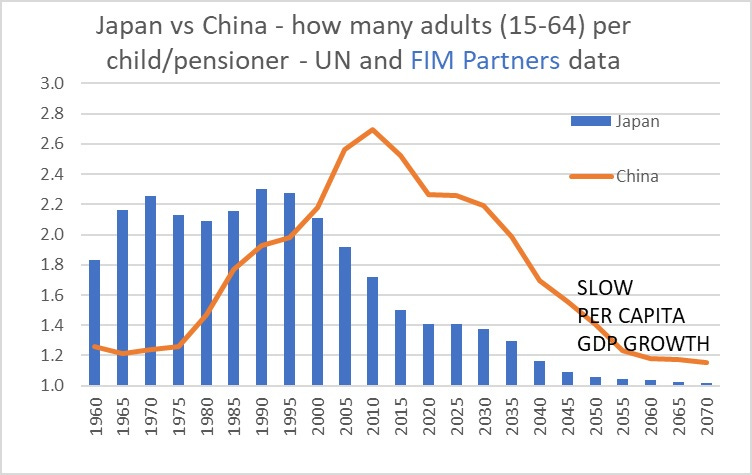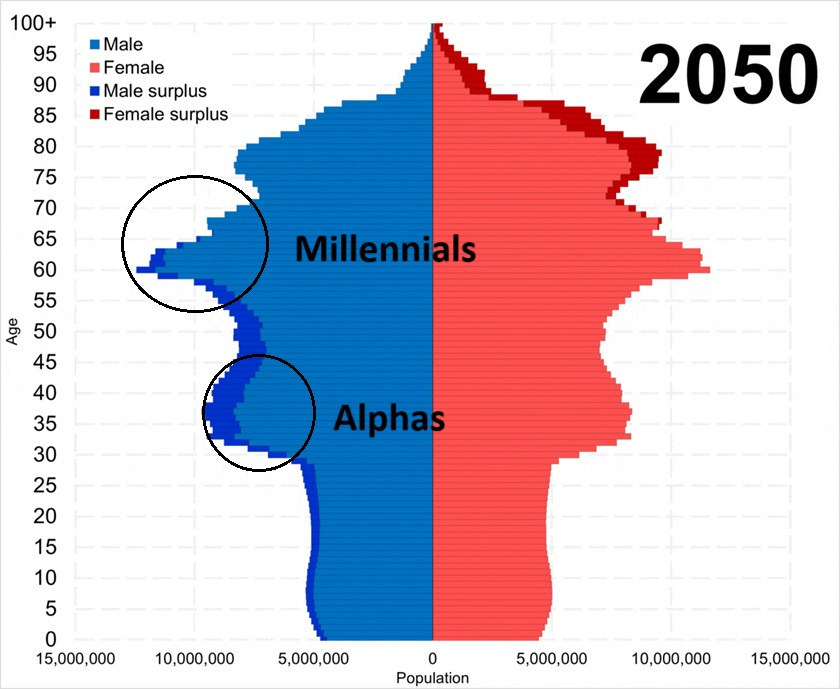China's demographics will be fine through mid-century
There is no imminent crisis.
In discussions about China’s economy, the issue of demographics comes up quite a lot. In 2022, China’s population began to decrease (and coincidentally, India’s population surpassed China’s). The country’s fertility rate, which had already fallen below replacement levels decades earlier, fell again recently, to just 1.09 — one of the lowest rates in the world, and even lower than Japan.
This is prompting a lot of hand-wringing about the future of China’s economy, both from people within China and from foreign observers. For example, here’s a quote in the WSJ:
“As the population peaks, China is showing signs of Japanification,” Yin Jianfeng, deputy director of the National Institution for Finance and Development, a state-backed think tank, wrote in an article published in June. Yin urged the Chinese government to spend more on child rearing and education to avoid the fate of Japan, which experienced decades of stagnation.
Here’s The Economist:
China’s economy risks shrinking, too, as a result. With an enormous burden of care on the horizon, the government senses an impending disaster…China is getting old before it gets rich. In 2008, when Japan’s population started to fall, its GDP per person was already about $47,500 in today’s dollars. China’s is just $21,000. As more of that money is spent on protecting ageing citizens, less of it will be available for the working generation to consume or invest.
And here’s the most dire post I could find, from The Conversation:
Population shifts can lead to a “doom loop”…As lower productivity begins to affect production in particular sectors, China may be compelled to increase imports to satisfy demand in those industries…This could significantly affect innovation and entrepreneurship which in turn can further diminish productivity. New ideas…drive economic growth. The size of the workforce affects innovation because as the number of employed individuals shrinks, the pool of new ideas becomes narrower…If population growth becomes negative or falls to zero, then the knowledge behind those ideas stagnates. In addition, there is evidence that the peak of a person’s innovative activities and scientific output comes at around 30 and 40 years of age…Current demographic trends are therefore likely to stifle technological advances and innovation in China…At the same time, studies suggest that entrepreneurship can be negatively affected by the ageing of the population as the percentage of young people is positively linked to entrepreneurial activities. This hampers the dynamism of the economy and contributes to slower economic growth.
Now, I absolutely do think this is a problem for China in the long term. In fact, China is far from unique in this regard — every developed country is aging rapidly, and most developing countries aren’t far behind.
And there really are negative consequences to population aging. I wrote about those problems in this post:
In fact, the shrinking of the population isn’t actually the problem — it’s the aging. Rising old-age dependency ratios do put a huge economic burden on working people, and an aging workforce probably does reduce innovation and productivity growth. This is true despite automation. A world top-heavy with old people will be a world where young people have to toil harder and harder, all over the globe.
But in the short term, I think the catastrophizing over China’s demographics is overdone. Americans searching desperately for a reason to dismiss China’s competitive threat might be tempted to seize on the country’s low fertility. But China’s economic might is not going to go “poof” and disappear from population aging; in fact, as I’ll explain, it probably won’t suffer significant problems from aging until the second half of this century.
Meanwhile, there’s an even greater danger that China’s leaders will panic over the country’s demographics and do something very rash. My former Bloomberg colleague Hal Brands has argued that China may start a war in Asia in the next few years out of fear that if it waits any longer, its power will decline — similar to how Germany rushed to war in 1914 because its leaders believed their window was vanishing. That worry is unfounded, as I’ll show. But it wouldn’t be the first rash blunder that Xi Jinping has made.
So it would be good for both Americans and Chinese people to understand the non-urgency of China’s demographic situation.
China has a baby bulge in the pipeline
The first and most important reason that China’s demographics are non-catastrophic is that they’ve got a large generation of young people, currently aged 5 to 15, that will relieve demographic pressure in the coming years.
Wikipedia has a good animated population pyramid for China, with data taken from UN forecasts. Here’s what the pyramid looks like for 2024. I’ve annotated the graph with generation labels, roughly corresponding to the similar generations in the United States:

As you can see, China’s current young working generation — the Zoomers — are a small generation. But the generation younger than that — the Alphas, currently aged 5 to 15 — are a bigger generation than the Zoomers.
China’s Alphas are not a true “baby boom” in the classic sense — there was no surge in fertility rates 5 to 15 years ago. Instead, the Alphas are a demographic echo of the large Millennial generation, which is itself an echo of China’s extremely large Baby Boom generation. The U.S. had a fertility rate of 3.5 during its Baby Boom; China’s was over 6. China has a lot of Alphas only because it had a truly enormous amount of Boomers back then.
Anyway, as the Alphas reach working age over the next decade, they will stabilize China’s demographics. China’s working-age population is actually projected to increase over the next few years, before beginning a slow decline:
As Charlie Robertson has shown, this will stabilize China’s dependency ratio at a very favorable level through the end of the decade:

China’s dependency ratio in 2030 will still be as good as Japan’s at the height of its economic miracle. Only by mid-century will China’s ratio deteriorate to the level of Japan’s in 2020.
So aging basically won’t be a problem for China’s workforce until mid-century. Around 2050, things start to look worse. China’s big Millennial generation will begin to age out of the workforce, and no large young cohort will be coming up to replace them:

This forecast assumes, of course, that the post-pandemic plunge in Chinese fertility rates doesn’t bounce back within the next decade. That remains to be seen. But whatever happens, China’s demographic structure is unlikely to have major problems for a quarter century.
China can compensate for aging in the short term
Even though China’s demographics don’t get severe until 2050 or so, it will still experience gentle aging over the next 26 years. Its median age is projected to rise from 39.5 to 50.7:
After 2027 or so, China’s working-age population will start to decline, and its dependency ratio will start to worsen.
None of this spells catastrophe, for reasons laid out in the previous section. But it does present a challenge. Fortunately for China, there are a couple of fairly easy policies it can use to compensate for the short-term burden of aging.
First, and most importantly, it can raise the retirement age. The country currently has the world’s lowest retirement age — just 60 for men and 50-55 for women. Simply changing this to 65 will decrease the dependency ratio significantly, and reduce the burden on working people. In fact, China reportedly plans to do this:
Jin Weigang, president of the Chinese Academy of Labor and Social Security Sciences, said China was eyeing a "progressive, flexible and differentiated path to raising the retirement age", meaning that it would be delayed initially by a few months, which would be subsequently increased.
"People nearing retirement age will only have to delay retirement for several months," the Global Times said, citing Jin. Young people may have to work a few years longer but will have a long adaptation and transition period, he said.
The second policy lever is something China has already done — increase the college enrollment rate. In 2010, only 26.5% of college-aged Chinese people were enrolled in postsecondary education; by 2023 that increased to 60.2%.
As every labor economist knows, a better-educated workforce is a more productive workforce. The Chinese workers that will retire over the next quarter century — the Gen Xers and older Millennials — are not very highly educated. The workers that will replace them — the Alphas — are very highly educated. That will compensate for much of the loss of working-age population.
Between welcoming a big youth cohort, raising the retirement age, and sending a lot more kids to college, China should experience few problems from the gentle demographic headwinds of the next two and a half decades.1 Its leaders still need to worry about the long-term demographic challenge after 2050, but most of its rivals are in even worse shape.
All in all, the narrative that demographics will tip the balance of economic and geopolitical power away from China in the next few decades seems overblown and unrealistic. That means more competition for the rest of the world to worry about. But it also means that China’s window of opportunity to act on the world stage won’t close anytime soon.
A lot of people will say that China can also A) use automation to compensate for loss of human labor, and B) move more people from the countryside to the cities. I’m skeptical of both of these. Regarding the first of these, the finding that aging decreases productivity holds true despite significant automation over the last few decades. So automation helps, but it doesn’t fully plug the gap yet (though perhaps with better AI it will). As for moving more workers to cities, official statistics claim that China’s urbanization rate lags that of other developed countries, but satellite evidence shows that China is already more densely urbanized than Germany. So I don’t see much upside there. But in any case, I don’t think China needs these factors to offset aging over the next 25 years — increased education and a higher retirement age should be enough to take care of it.






Definitions of working age as 15-64, and dependency ratios derived from that are obsolete, but still used because of the conservatism of statistical agencies. This range made sense when most young people didn't complete high school, and when the demands of physical work meant few could work past the pension age of 64. A more appropriate range would be something like 20-70. That wipes out the effects of about 30 years of population aging.
Automation has hardly begun in China, or the rest of the world. Most firms still employ relatively little automation.. There are only around 3.4 million industrial robots globally, while the rate at which automation is 'improving' (able to do more physical and mental tasks) is still exponential. The scope for robots/AI/AR/VR in industrial, commercial and construction applications, and even the home, is hardly tapped. The problem is not lack of workers... it is how to shift the economy from 'growth' based on 'growing population' to 'growth' based on continuous improvement in the natural and built environment, as well as growth in 'living standards'. Towns and infrastructure, as well as 'the natural world', can always be improved and better maintained/rehabilitated. In time, China can have fewer firms building new houses/apartments and more renewing what is there to cater for a falling population with a shifting age profile. With a Universal Basic Income set to keep the labour market in 'dynamic balance', China can have it all, so that at some point people will feel secure enough, and with enough 'free time', to again want to have the 'obligatory' 2.1 kids to stabilize the population. Hopefully, this takes place only after the population has shrunk to say half its size now.... the same with the rest of the world.